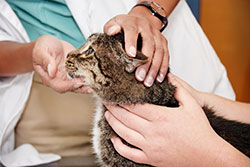Hybrid Veterinary Assistant Program Lets You Learn Online

Veterinary assistant training can only prepare you for a career if your chosen school offers real-world experience.. You might think that getting that kind of practical experience is only possible with an in-person , veterinary assistant course, but that is not the case.The Animal Behavior College (ABC) Veterinary Assistant Program gives you both a thorough educational foundation and real-world experience complete with all the convenience, flexibility and affordability of online learning.
The The way it works makes a lot of sense. The first stages of the curriculum are done online. The various stages give you a good overview of veterinary medicine and the responsibilities you’ll have, such as preparing exam rooms, laboratory procedures, and animal restraint.
Once you’ve completed the online part of the program, you will be given the opportunity to work in an actual animal hospital setting during your “externship” at a local mentor facility.
Vet Assistant Career Earning Potential




*Source: Bureau of Labor Statistics, Salary.com & Indeed.com 2024. Hourly rates may vary in your area.
The externship enables you to use your newfound knowledge and skills and allows you to see what it’s like to work in an animal healthcare environment. You’ll work closely with veterinary personnel to gain hands-on experience as you move closer to launching your new animal career.
ABC graduates leave the program well-prepared for a career working with animals in veterinary offices and other facilities that care for animals or keep animals in captivity, such as zoos and wildlife sanctuaries.
Be Our Next Success Story!
NAVTA-Approved Veterinary Assistant Training
Our curriculum follows the vet assistant requirements set forth and approved by the National Association of Veterinary Technicians in America (NAVTA) in cooperation with AVTE (Association of Veterinary Technician Educators) & CVTEA (Committee on Veterinary Technician Education and Activities).1
In 1972, the House of Delegates authorized a program of accreditation of training for animal technicians – the Committee on Veterinary Technician Education and Activities (CVTEA). Their objective is to recognize veterinary technician training programs that are fully capable of graduating acceptable assistants for veterinarians and to assist in the development of such programs, as well as to study all matters pertaining to activities of veterinary technicians, and to advise the Board of Directors concerning the implementation of AVMA policy concerning such matters.2
The AVTE was founded in 1973 to promote professional education to veterinary technology students in the United States and Canada. They advocate cooperation among organizations, institutions and all of those interested in veterinary technology.
NAVTA was formed in 1981, allowing veterinary technicians to provide input on national issues involving the veterinary community.3
Veterinary Assistant Requirements By Stage
The curriculum for our Veterinary Assistant Program provides you the knowledge and skills to become a veterinary assistant. There are 11 stages that include an online vet assistant course, 47 educational videos and your externship.

Stage 1 – OFFICE ETIQUETTE AND HOSPITAL PROCEDURES – 21 Days
In this stage, you will learn how to work in a professional animal hospital environment. As a veterinary assistant, it will be your responsibility to assist the veterinarian and veterinary technician in completing important tasks within the animal hospital or clinic.
Becoming familiar with your responsibilities, as well as those of other members of the staff, will be invaluable to completing your tasks professionally and efficiently. Coexisting with and abiding by current hospital protocol, maintaining a professional appearance, and speaking and interacting with others politely, are all vital aspects of the veterinary assistant position that will gain you the respect of hospital staff, fellow animal caretakers and clients.
Stage 2 – ANIMAL BEHAVIOR AND HANDLING – 21 Days
Animal Behavior and Handling focuses on two vital areas of knowledge for the veterinary assistant: understanding animal behavior and body language, and proper handling and restraint procedures. Implementing these skill sets together in a veterinary setting is the foundation for ensuring safe staff and effective patient interactions.
This stage introduces the student to a range of feline and canine physical postures and vocalizations that communicate an animal’s emotional state at any given moment. Becoming familiar with the physical and vocal language of animals gives the veterinary assistant an important set of tools to keep themselves and the animals they assist safe.
This stage also guides the student through proper restraint techniques during various medical procedures and instructs students on lifting animals, placing them in recumbent positions, and placing them in or removing them from enclosures.
 Stage 3 – EXAMINATION ROOM PROCEDURES – 14 Days
Stage 3 – EXAMINATION ROOM PROCEDURES – 14 Days
The veterinary assistant’s role during any type of veterinary examination is to make the jobs of the veterinarian and veterinary technician easier by cleaning and preparing the exam room and making sure it contains the necessary supplies; taking the patient’s history and vital signs; communicating with the pet owner; and completing any other tasks requested by the veterinarian or vet tech.
A knowledgeable veterinary assistant trained in handling emergencies can even participate in saving a patient’s life. This stage equips you with key information about the vital role you will play during examination room procedures.
Stage 4 – PHARMACY AND PHARMACOLOGY – 14 Days
There are myriad medications used in the veterinary environment to help sick and injured animals return to health or maintain their current state of health.
Pharmacy and Pharmacology educates you about different aspects of the veterinary assistant’s role in filling prescriptions, administering drugs, accurately dispensing medication and talking to pet owners to make sure they understand their pets’ prescription(s) and how to safely administer them at home. This stage has two veterinary assistant training videos to supplement the vet assistant course.
Stage 5 – SURGICAL PREPARATION AND ASSISTING – 35 Days
Most animals will likely undergo certain surgical procedures during their lifetime. Surgeries that are scheduled by choice and/or ahead of time (i.e., spaying/neutering) are elective surgeries. In the case of elective surgeries, the veterinary staff and pet owner have advance notice to get the patient, staff and operating room ready for the procedure. If there is a medical emergency that must be dealt with immediately through surgical procedure (i.e. fractured limbs), it is a non-elective surgery. Non-elective surgeries do not grant the convenience of forewarning and must be fit into the staff’s schedule at a moment’s notice.
No matter how skilled the surgeon at your veterinary hospital, competent preparation by veterinary staff is needed to ensure a successful procedure without complications. The surgical suite, instruments, and equipment must be set up for efficiency, disinfected, and confirmed to be in working order. Obtaining patient history and background ensures that they can physically handle the surgery, and be safely anesthetized.
In order to be able to adeptly assist the veterinarian and/or veterinary technician during this phase of an animal’s medical treatment, you must first learn how to assist in surgical preparations. This section will provide you with basic knowledge of preparing for surgery.
Stage 6 – SMALL ANIMAL NURSING – 35 Days
Veterinary practices typically focus on either large animals or small animals because these two branches of veterinary medicine vary enormously. Large animal veterinarians treat animals like horses, cows, sheep, goats, pigs, llamas and alpacas. They have specific training, alternate equipment and offer different services. Treating large animals also usually requires travel to the patient’s home as they are too large to conveniently transport. Otherwise, large animals are brought into a large animal hospital by trailer, where they are treated and released or hospitalized in stalls instead of cages.
Small animal medicine encompasses canines, felines, rodents or “pocket pets” (e.g., mice, rats, gerbils, ferrets and chinchillas), rabbits, birds and animals of similar size. Smaller pets can be taken to a veterinary clinic. Our curriculum focuses on small animals; and this stage teaches you about common procedures the veterinary assistant completes when nursing patients back to health. You will also learn about grooming tasks that every veterinary assistant should be able to complete with ease. An apt assistant is always learning and adding skills to their repertoire.
Stage 7 – LABORATORY PROCEDURES – 21 Days
In this stage, you will learn how to prepare samples for analysis, conduct simple laboratory tests, and record the results accordingly as requested by the veterinarian. These tests commonly follow the patient’s examination. Laboratory test results are interpreted by the veterinarian and help them to diagnose and create an effective treatment plan for the patient. Tests must be completed in a timely manner with great attention to accuracy.
The well-educated veterinary assistant will be able to efficiently and proficiently complete laboratory tests such as those to measure and monitor changes within the patient’s body, verify organ function, monitor drug levels, and track the presence of pathogens.

Stage 8 – RADIOLOGY ULTRASOUND IMAGING AND ENDOSCOPY – 21 Days
Radiology is the major diagnostic imaging technique available to the modern veterinarian. The veterinarian’s ability to accurately use the images, however, relies on the quality of the images themselves. Performing skillful diagnostic imaging is usually the responsibility of the veterinary technician, with active assistance from the veterinary assistant; thus, the knowledgeable veterinary assistant becomes familiar with all radiological procedures completed within the veterinary facility so they can proficiently assist in their completion. This stage will teach you the knowledge essential for assisting in veterinary diagnostic imaging.
Stage 9 – CAREER BUILDING – 14 Days
This stage provides you with guidance on choosing the right career and facility for you, searching for a job, creating an exceptional cover letter and résumé, excelling during any type of interview, setting yourself up to succeed on the job and maintaining your new career long term. Whether becoming a veterinary assistant is a career change or the start of your professional experience altogether, this guidance will assist you in cementing the foundation of your career in veterinary medicine.
Stage 10 – EXTERNSHIP – Up to 20 Weeks
Upon reaching Stage 10, you’ll have the opportunity to reinforce your studies by seeing what you have learned put to practice in an animal hospital setting.
The on-site training portion of our NAVTA-approved Vet Assistant Program is critical to helping you become a veterinary assistant. It also provides valuable feedback from the mentor facility on everything from your skill sets to attendance and professional demeanor.
Since ABC strives to provide the best educational experience possible for our students, we encourage feedback from the entire staff at the veterinary facility. The facility will provide input on the skills sets that will determine if a veterinary assistant career is the right choice for you. Although it’ll be up to the veterinary facility to determine the aptitude of each student and the tasks they feel the student is capable of performing, your actions and your willingness to learn can maximize your real-world experience.
Pet CPR and First Aid Certification
Being a professional in any animal care career is accompanied by the responsibility of being able to react calmly and safely in the event of an emergency. Animal Behavior College’s Pet First Aid and CPR Certification will give you the knowledge needed to respond safely and effectively to medical emergencies like choking, heat stroke, bleeding injuries, and poisonous bites from insects and snakes.
You’ll also learn how to artificially keep a pet’s heart and lungs working until you can seek veterinary help along with many other vital life-saving skills. By learning what can happen and how to respond appropriately, you may prevent many pet emergencies from ever happening and thereby help ensure the safety of not only your own pets, but also any pets in your care.
Stage 11 – GRADUATION – 16 Days
The Final Exam is given once your vet assistant course and externship have been successfully completed. You’ll review all of the material presented in the previous stages to prepare for the final. This review time is allotted for you to re-read and study the various concepts that have been taught. The Final Exam is designed to test your overall knowledge of skills required to become a veterinary assistant and will cover all areas of the curriculum.
Benefits of ABC Vet Assistant Training
Study from the Privacy of Your Own Home
When you choose to enroll in ABC’s Veterinary Assistant Program of study, you can keep your present job while completing your veterinary assistant training. The online portion of our vet assistant course brings the classroom to your living room and neighborhood, saving you time and money from having to live near and commute to campus.
Flexible Hours
Learn on your own time at your own pace. Getting your education online gives you the freedom to study around your current work or school schedule. With this flexibility, the normal completion time is 52 weeks.
Our Program Manager Team
During the program, our ABC Program Manager team will guide you through the program, counsel you, answer your questions and grade your exams. On of our Program Managers will contact you shortly after enrollment to get acquainted and welcome you into the program. At that time, you’ll be given the Program Manager’s contact information for future interactions and assistance as you journey through the program. Start studying to become a vet assistant today. Call 800-795-3294 to sign up for our vet assistant course.
Short Term Programs
ABC offers Short Term Programs to those individuals interested in continuing their education. Although you may sign up for any of the Short Term Programs upon enrollment, you will only be granted access once you have successfully completed stage 3. This is done to ensure you have the knowledge necessary to maximize your learning experience.
Training Shelter Dogs
As an ABC Certified Dog Trainer, you may encounter dogs temporarily residing in shelters and rescues due to owner relinquishment. This devastating situation calls for immediate attention. This program consists of 250+ pages of digital material authored by Teoti Anderson, former president of the APDT, with contributions from Kelly Gorman-Dunbar and numerous members of the ABC staff. The wealth of information provided discuss understanding the different kinds of shelters, how to approach them, identifying dogs for adoption and defensive handling, as well as temperament assessments, including some excellent information from the ASPCA MYM Safer Program.
Upon completion of this program, you’ll have a solid foundation of knowledge regarding the training and treatment of shelter dogs with specific attention to re-homing. You’ll also learn the skills that could help launch an animal shelter or dog rescue training program. You may hold classes for dog owners and/or seminars to improve the knowledge of people in your community. As an ABC Certified Dog Trainer, you may have the opportunity to not only train shelter dogs, but to place them in permanent, loving homes as well. Every hour spent with a shelter dog makes a world of difference and, upon completion of the Training Shelter Dog Program, you’ll have the knowledge to positively transform the lives of shelter dogs.
This Short Term Program is approved by the International Association of Canine Professionals (IACP) and the National Association of Dog Obedience Instructors (NADOI) for CEU credits.
The Art of Selling and Teaching Private Lessons
Understanding how to conduct private dog training sessions is a crucial component of a professional dog trainer’s career. There are several reasons why learning how to offer quality private lessons is greatly beneficial to your training repertoire. Some clients are better served by one-on-one, individualized, personalized training rather than a group class atmosphere— perhaps the client’s schedule is especially hectic, her puppy is not of age to attend group classes or her older dog’s shyness renders him uncomfortable when forced to interact with other dogs. Regardless of the particular client’s reason, the demand for private-lesson training can be a wonderful opportunity for the professional dog trainer.
The Art of Selling and Teaching Private Lessons is comprised of approximately 300 pages of highly-detailed digital information on conducting private lessons. Authored by Teoti Anderson, former president of the Association of Pet Dog Trainers (APDT), this Short Term Program will bolster your knowledge of proper private-lesson training and will instruct you on such imperative topics as sales techniques and tips, understanding communication styles, the different types of private training, developing effective training plans, how to teach off-leash behaviors, and how to achieve client compliance in order to maximize your training. Additionally, this program covers advanced tips for marketing yourself and your business and includes information on liability protection.
Upon completion of this program, you’ll have the knowledge to offer and conduct private lessons within a client’s home, at a local park or at your own facility. Your knowledge of how to obtain clientele and conduct efficient private lessons may assist you in growing your business and maximizing its potential.
This Short Term Program is also approved by the International Association of Animal Behavior Consultants (IAABC), the International Association of Canine Professionals (IACP) and the National Association of Dog Obedience Instructors (NADOI) for CEU credits.
Pet Sitting and Dog Walking
This program provides detailed information on the proper care of and interaction with a variety of pets—dogs, cats, birds, small mammals, fish and reptiles. Subjects include understanding animal communication, such as body language and vocalization, basic nutrition and hygiene, and first aid and safety. You’ll also learn how to: build relationships with clients and their pets, ensure personal and homeowner safety, create and maintain schedules, build clientele, and much more—everything you need to know to start your own pet sitting and/or dog walking business. Upon completion of this course, you’ll have a new and highly sought after service to provide to existing and future clients and their pets.
Pet Nutrition and Diet
The Pet Nutrition and Diet Short Term Program discusses basic pet nutrition, the regulations governing commercial pet foods, and the nutritional needs for both cats and dogs. In this course, you’ll learn how to read pet food labels, including the importance of carbohydrates, fats, proteins, vitamins, minerals, and protective nutrients. You’ll also learn about the different types of diets (i.e. dry food, canned food, raw food, supplements, etc.) and how food can play a huge role in a pet’s behavior. After the completion of this program, you’ll have the knowledge to educate your clients on how to provide their animals with proper nutrition based on their pet’s individual age, weight and health condition.
Pet Massage
The Pet Massage Short Term Program gives pet groomers, dog trainers and veterinary staff the knowledge on how to calm each pet they interact with. The ability to soothe and calm dogs through touch improves the human-animal relationship and promotes trust and bonding. This comprehensive course includes step-by-step instructions that guide you through the details of the choreography of a massage for different sizes and types of pets. Topics include: general anatomy and physiology, principles and concepts for different types of massage, creating your workspace, preparing yourself, details for how to develop a pet massage business, and much more!*
This Short Term Program is also approved by the International Association of Animal Behavior Consultants (IAABC), the International Association of Canine Professionals (IACP) and the National Association of Dog Obedience Instructors (NADOI) for CEU credits.
*State and federal laws regarding the practice of Pet Massage vary widely and are subject to change. Since ABC has no jurisdiction regarding state and federal laws revolving around the practice of Pet Massage, ABC highly recommends that potential students educate themselves on the state and federal laws and regulations and how that may affect their practice of Pet Massage before purchasing the ABC Pet Massage Short Term Program. It’s the responsibility of potential students to determine what laws and regulations their state has adopted to govern the practice of Pet Massage. ABC doesn’t assume any responsibility for state or federal regulations that prohibit or limit the practice of pet massage by the student.
Doggie Daycare
Our Doggy Day Care Short Term Program is designed to equip you with the essential skills and knowledge needed to successfully create, set up, and operate a doggie daycare business. Whether you’re a passionate dog lover or an aspiring entrepreneur, this program will guide you through every step of the process. You will gain a solid understanding of fundamental business principles that are crucial for running a successful daycare. This course will give you the basics of running a business, including financial management, marketing strategies and operational logistics. Learn effective methods for managing groups of dogs safely and efficiently.
Our training covers canine behavior, socialization practices, and safety protocols to ensure a harmonious environment for both pets and staff. In addition to foundational knowledge, this short-term program offers valuable tips on how to expand your clientele. By the end of this course, you will be well-prepared to launch your doggie daycare venture with confidence and expertise.
This Short Term Program is also approved by the International Association of Animal Behavior Consultants (IAABC), the International Association of Canine Professionals (IACP) and the National Association of Dog Obedience Instructors (NADOI) for CEU credits.
Pet Fostering
Our Pet Fostering Short Term Program provides you with the essential knowledge and skills needed to establish a successful pet fostering program within an existing rescue organization or animal shelter. Throughout the course, you will gain insights into effective strategies for selecting and retaining dedicated volunteers who are passionate about animal welfare. You will also learn how to expertly match foster animals with suitable volunteers, ensuring a harmonious and supportive environment for both parties.
Additionally, the curriculum covers vital skills necessary for the ongoing management and sustainability of a thriving fostering program. By the end of this course, you will be equipped with practical tools and techniques that will empower you to enhance your organization’s fostering efforts, ultimately leading to better outcomes for animals in need.
Pet Fostering is approved by the International Association of Canine Professionals (IACP) and for CEU credits.
Sources:1. National Association of Veterinary Technicians in America
2. American Veterinary Medical Association
3. Animal Behavior College





